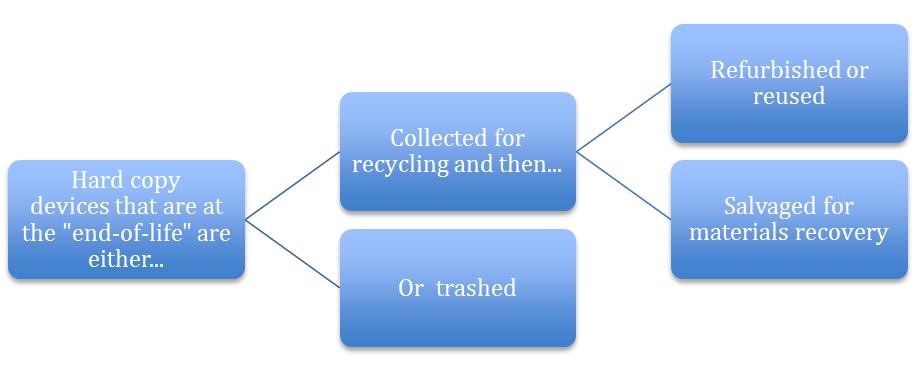A Darker Shade of Green: End-of-Life Device Recycling
Spring is in the air and the fancy of organizations across the Pacific Northwest now turns to sustainability. Smart thinking. Making the connection between your organization’s office printing environment and our fragile planet’s environment is not only the right thing to do–it is the strategic thing to do. Unmanaged printer fleets expand in size and complexity in response to even the slightest growth. Think about it. The economy and wireless technologies are seemingly changing with the tides and the entire globe is drowning in e-waste. Coincidence?
According to the Environmental Protection Agency (EPA)[i], the average lifespan of hard copy devices — AKA: office printing technology — is now less than five years. As you can see in the diagram below, when these devices reach the end of your road, there are just two ways they can go: “recycling” or the trash.
A close look at the latest EPA data (2010) below reveals “recycling” is by far the path less travelled.
That’s bad news when you consider the potential health risk posed by the toxic heavy metals, semimetals, and chemicals discarded e-waste may contain. Here are some highlights of three of the scariest:
But before you consider shipping that putty-colored box formerly known as your printer (or copier, MFP, fax machine etc.) off to live happily ever after in recycling nirvana, there’s something you should know. Experts believe that about 80% of electronics claimed to be recycled in the US are really exported (some working some not) to developing countries. [i] Whether working or not, the vast majority of these devices will be harvested for materials in unsafe working conditions using primitive technology that poisons workers and their communities.
As much as we love to sell innovative printing technology to organizations when they need it, we believe that it is important to consider these serious consequences associated with buying a new printer. We all know the easiest thing to do is not always the right thing to do.
So why don’t more organizations repair and repair printing devices instead? Perhaps it is because they are:
- Faced with a mish-mash of aging printers, and mix-and match brands and don’t know where to start.
- Too busy doing what they actually do best.
- Online having fun while learning more about e-waste by watching “The Story of Electronics”. See it for yourself at: https://www.storyofstuff.org/movies/story-of-electronics/
You may be already letting Copiers Northwest take care of it since that’s what we do best. If not, give us a call to see how Copiers Northwest can help you manage your fleet, so that you can reduce, repair and recycle more efficiently – all while addressing printer downtime and unpredictable service charges.
Please contact us at 866.692.0700 so we can talk about your specific environment and expectations.
[i] “Frequently Asked Questions,” The Coalition for American ElectronicsRecycling, Updated Feb 27, 2012, https://www.americanerecycling.org/faq.html
[i] “Electronics Waste Management in the United States Through 2009,” May 2011 EPA 530-R-11-002.



